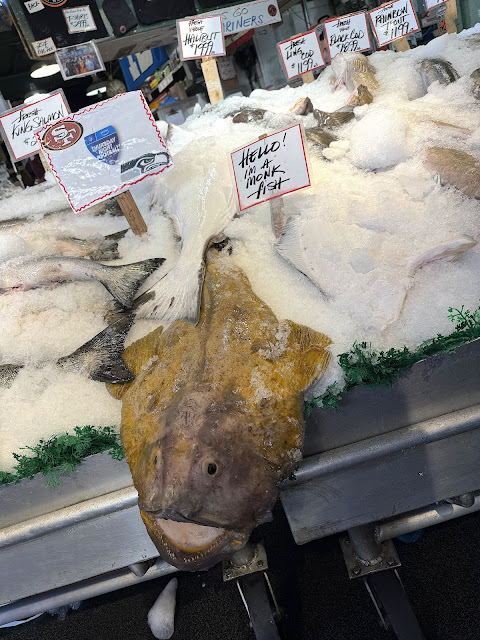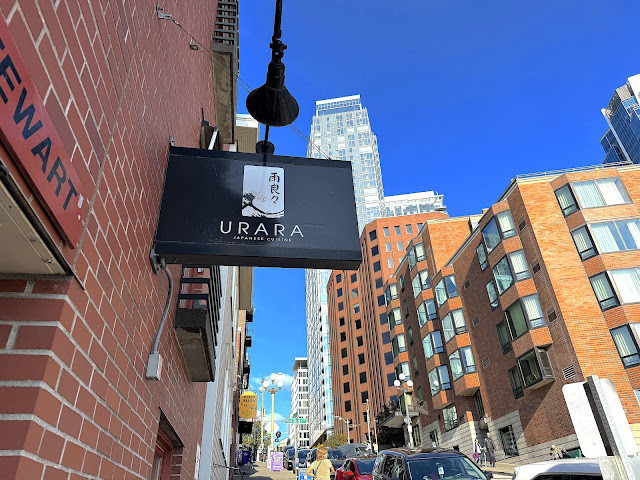 I've been to Seattle about half a dozen times, the most recent six years ago. Read my four postings (1, 2, 3, and 4). The highlight was Chihuly Garden and Glass.
I've been to Seattle about half a dozen times, the most recent six years ago. Read my four postings (1, 2, 3, and 4). The highlight was Chihuly Garden and Glass.About Seattle:
- The area was inhabited by the Duwamish 4000 years before the Europeans came, led by George Vancouver of Great Britain in 1792.
- An American, Arthur Denny, arrived on a ship in 1851 and founded the city. Named after Chief Seattle, leader of the Duwamish and Suquamish tribes.
- Like Rome, the city is built on seven hills. Well, maybe 12.
- The city is 41% by area water.
- Seattle is cloudy 201 days out of the year, with 93 partly cloudy. It has a well-earned reputation for rain, but only drizzles, for New York Ciity, Miami and Houston have more actual rainfall/year.
- Logging was the first major industry.
- The Great Seattle Fire of 1889 destroyed the central business district.
- Became the gateway to Alaska during Klondike Rush between 1896-9.
- American Messenger Company was founded in 1907 by 19-year old James Casey, who borrowed a $100 from a friend. Now known as UPS. Nordstrom and Eddie Bauer also were established here during this period.
- The Alaska-Yukon-Pacific Exposition of 1909 became the campus of the University of Washington.
- Shipbuilding boomed during World War I.
- The Great Depression into the 1930's resulted in violence, labor strife and homelessness. The Asian Pacific population especially suffered.
- World War II established Boeing aircraft manufacturing
- The Century 21 Expo of 1962, also known as the Seattle World's Fair, with the Space Needle, restored some prosperity.
- City has had a history of boom-and-bust cycles, but beginning in 1979, Microsoft set up shop here, then Amazon in 1994, followed by a stream of software, internet and biotechnology companies.
- The 1993 film Sleepless in Seattle, with Tom Hanks, brought attention, as did the television sitcom Frazier.
- The dot-com boom caused frenzy until 2001, when the bubble burst.
- That year also saw the 6.8 magnitude Nisqually earthquake. Seattle is located on the Pacific Ring of Fire. There was a 9 magnitude earthquake in 1700.
- A bigger threat is the Cascadia subduction zone, with a 9.0 quake expected in the future.
- The population was 188 in 1860, 80,671 in 1900, 237,194 in 1910 and 755,000 or so today.
- 62% White, 16% Asian, 7% Hispanic and 7% Black. Was 92% White in 1960.
- Median income for a family is about $130,656.
- Has 54,200 millionaires and 11 billionaires.
- 8000 homeless people.
- There is three block area next to Pike's Market we were told to avoid because of crime. Did not know that when we had lunch today right in that area.
- Professional sport teams cover the NFL, MLB, NHL MLS, WNBA and MLR.
- One of the most socially liberal cities in the U.S. 80% Democrats.
- Has 20 sister cities, including Bergen, Kobe and Reykjavik.
Yesterday, on to Pike's Market and lunch with friends. A few photos.
Fish market.
Salmon tossing.
Lots of flowers.
Cabbage.
Carrots.
Zucchini plant.
Kohlrabi plant.
Bronze pig.
Psychedelic booth.
Long lines to get into Starbucks.
Blue-bar pigeon continued to lead the way.
Another bird.
A new part of Pike's Market that just opened the other day.
Looking the other way, the Norwegian Jewel, about where our Encore will be berthed on Sunday.
Went to lunch at Urara,
My sashimi and unagi don, miso soup and Rainier Beer.
Steve and Debbie had Champons.
Eventually back to our hotel and Executive Club for sunset.
Tomorrow, the Space Needle and Chihuly Garden and Glass.
-

































Comments
Post a Comment